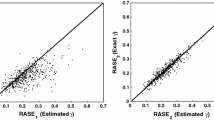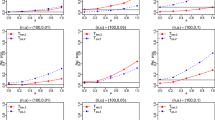Abstract
Generalized additive partially linear models enjoy the simplicity of GLMs and the flexibility of GAMs because they combine both parametric and nonparametric components. Based on spline-backfitted kernel estimator, we propose empirical likelihood (EL)-based pointwise confidence intervals and simultaneous confidence bands (SCBs) for the nonparametric component functions to make statistical inference. Simulation study strongly supports the asymptotic theory and shows that EL-based SCBs are much easier for implementation and have better performance than Wald-type SCBs. We apply the proposed method to a university retention study and provide SCBs for the effect of the students information.


Similar content being viewed by others
References
Chen SX, Qin YS (2000) Empirical likelihood confidence intervals for local linear smoothers. Biometrika 87:946–953
Hastie TJ, Tibshirani RJ (1990) Generalized additive models. Chapman and Hall, London
Horowitz J, Mammen E (2004) Nonparametric estimation of an additive model with a link function. Ann Stat 32:2412–2443
Horowitz J, Klemelä J, Mammen E (2006) Optimal estimation in additive regression models. Bernoulli 12:271–298
Liang H, Qin Y, Zhang X, Ruppert D (2009) Empirical-likelihood-based inferences for generalized partially linear models. Scand J Stat 36:433–443
Linton OB (1997) Efficient estimation of additive nonparametric regression models. Biometrika 84:469–473
Linton OB, Härdle W (1996) Estimation of additive regression models with known links. Biometrika 83:529–540
Linton OB, Nielsen JP (1995) A kernel method of estimating structured nonparametric regression based on marginal integration. Biometrika 82:93–100
Liu R, Yang L (2010) Spline-backfitted kernel smoothing of additive coefficient model. Econ Theory 26:29–59
Liu R, Yang L, Härdle W (2013) Oracally efficient two-step estimation of generalized additive model. J Am Stat Assoc 108:619–631
Liu R, Härdle WK, Zhang G (2017) Statistical inference for generalized additive partially linear models. J Multivar Anal 162(c):1–15
Ma S, Yang L (2011) Spline-backfitted kernel smoothing of partially linear additive model. J Stat Plan Inference 141:204–219
Ma S, Carroll RJ, Liang H, Xu S (2015) Estimation and inference in generalized additive coefficient models for nonlinear interactions with high-dimensional covariates. Ann Stat 43:2102–2131
Ma S, Racine S, Yang L (2015) Spline regression in the presence of categorical predictors. J Appl Econ 30:705–717
Owen A (2001) Empirical likelihood. Chapman & Hall/CRC, London
Park B, Mammen E, Härdle W, Borak S (2009) Time series modelling with semiparametric factor dynamics. J Am Stat Assoc 104:284–298
Portnoy S (2011) Local asymptotics for quantile smoothing splines. Ann Stat 25:414–434
Severini T, Staniswalis J (1994) Quasi-likelihood estimation in semiparametric models. J Am Stat Assoc 89:501–511
Stone CJ (1985) Additive regression and other nonparametric models. Ann Stat 13:689–705
Stone CJ (1986) The dimensionality reduction principle for generalized additive models. Ann Stat 14:590–606
Sun Y, Sundaram R, Zhao Y (2009) Empirical likelihood inference for the cox model with time-dependent coefficients via local partial likelihood. Scand J Stat 36:444–462
Wang L, Yang L (2007) Spline-backfitted kernel smoothing of nonlinear additive autoregression model. Ann Stat 35:2474–2503
Wang J, Yang L (2009) Efficient and fast spline-backfitted kernel smoothing of additive models. Ann Inst Stat Math 61:663–690
Wang L, Liu X, Liang H, Carroll RJ (2011) Estimation and variable selection for generalized additive partial linear models. Ann Stat 39:1827–1851
Xue L, Liang H (2010) Polynomial spline estimation for a generalized additive coefficient model. Scand J Stat 37:26–46
Xue L, Yang L (2006) Additive coefficient modeling via polynomial spline. Stat Sin 16:1423–1446
Yang L, Sperlich S, Härdle W (2003) Derivative estimation and testing in generalized additive models. J Stat Plan Inference 115:521–542
Zheng S, Liu R, Yang L, Härdle W (2016) Statistical inference for generalized additive models: simultaneous confidence corridors and variable selection. Test 25:607–626
Acknowledgements
The authors thank the editor and two anonymous referees for their constructive and insightful comments and suggestions to improve the manuscript. Yichuan Zhao acknowledges the support from both the NSF Grant (DMS-2006304) and the NSA Grant (H98230-19-1-0024).
Author information
Authors and Affiliations
Corresponding author
Additional information
Publisher's Note
Springer Nature remains neutral with regard to jurisdictional claims in published maps and institutional affiliations.
Electronic supplementary material
Below is the link to the electronic supplementary material.
Appendix A: Assumptions and proofs
Appendix A: Assumptions and proofs
We mean by “\(\sim \)” both sides having the same order as \(n\rightarrow \infty \) in the rest of the paper. To obtain EL SCBs, we need the following assumptions which are similar assumptions to construct Wald-type SCBs. See Liu et al. (2017) for more details.
(A1) The additive component functions \(m_{\alpha }\in C^{\left( 1\right) }\left[ 0,1\right] ,1\le \alpha \le d_{2}\) with \(m_{1}\in C^{\left( 2\right) }\left[ 0,1\right] \), \(m_{\alpha }^{\prime }\in \mathrm{Lip}\left( \left[ 0,1\right] , C_{m}\right) , 2\le \alpha \le d_{2}\) for some constant \(C_{m}>0\).
(A2) The inverse link function \(b^{\prime }\) satisfies \(b^{\prime }\in C^{2}\left( {\mathbb {R}}\right) ,b^{\prime \prime }\left( \theta \right) >0,\theta \in {\mathbb {R}}\) while for a compact interval \(\Theta \) whose interior contains \(m\left( \left[ 0,1\right] ^{d_{2}}\right) \), \(C_{b}>\max _{\theta \in \Theta }b^{\prime \prime }\left( \theta \right) \ge \min _{\theta \in \Theta }b^{\prime \prime }\left( \theta \right) >c_{b}\) for constants \( C_{b}>c_{b}>0\).
(A3) The conditional variance function \(\sigma ^{2}\left( {\mathbf {x}}\right) \) is measurable and bounded. The errors \(\left\{ \varepsilon _{i}\right\} _{i=1}^{n}\) satisfy \({\mathsf {E}}\left( \varepsilon _{i}|{\mathbf {T}}_{i}^{{\top }},{\mathbf {X}}_{i}^{{\top }}\right) =0\) and \({\mathsf {E}}\varepsilon _{i}^{6}<\infty \).
(A4) The density function \(f\left( {\mathbf {x}}\right) \) of \(\left( X_{1},\ldots ,X_{d_{2}}\right) \) is continuous and
The marginal densities \(f_{\alpha }\left( x_{\alpha }\right) \) of \(X_{\alpha }\) have continuous derivatives on \(\left[ 0,1\right] \) as well as the uniform upper bound \(C_{f}\) and lower bound \(c_{f}\).
(A5) \(\left\{ {\mathbf {Z}}_{i}=\left( {\mathbf {T}}_{i}^{{\top }},{\mathbf {X}} _{i}^{{\top }},\varepsilon _{i}\right) \right\} _{i=1}^{n}\) are independent and identically distributed.
(A6) There exist constants \(0<c_{\delta }<C_{\delta }<\infty \) and \( 0<c_{{\mathbf {Q}}}<C_{{\mathbf {Q}}}<\infty \) such that \(c_{\delta }\le {\mathsf {E}}(\left| T_{k}\right| ^{2+\delta }\mid \mathbf {X=x})\le C_{\delta }\) for some \(\delta >0,\) and \(c_{{\mathbf {Q}}}I_{d_{1}\times d_{1}}\le {\mathsf {E}}\left( \mathbf {TT}^{\top }\mid \mathbf {X=x}\right) \le C_{{\mathbf {Q}} }I_{d_{1}\times d_{1}}\).
(A7) The kernel function K is a symmetric probability density, supported on \(\left[ -1,1\right] \) and \(K\in \mathrm{Lip}\left( \left[ -1,1\right] ,C_{K}\right) \) for some positive constant \(C_{K}>0\). The bandwidth \(h=h_{n}\) \( \sim n^{-1/5}(\log n)^{-1/4}\).
(A8) The number of interior knots satisfies: \(N\thicksim n^{1/4}\log n,\) i.e., \(c_{N}n^{1/4}\) \(\log n\le N\le C_{N}n^{1/4}\log n\) for some positive constants \(c_{N}\),\(C_{N}.\)
Lemma A.1
Under Assumptions (A1)–(A7), as \(n\rightarrow \infty \),
with
In addition,
Proof
See the supplement. \(\square \)
Lemma A.2
Under Assumptions (A1)–(A8), as \(n\rightarrow \infty \),
and
Proof
See the supplement. \(\square \)
Proof of Theorem 1
See the supplement. \(\square \)
Proof of Theorem 2
Denote
with \(W\left( s\right) \) a Wiener process. According to the equation (27) in Sun et al. (2009), one has that
where \(r_{h},d_{h}\) are defined in Theorem 2. According to equation (A.11) in the supplement, one has
due to Eq. (A.2). According to equation (A.7) in the supplement and Theorem 1 in Zheng et al. (2016),
Therefore,
Then, the theorem is proved by replacing \(G\left( x_{1}\right) \) by \(-2\log {\tilde{R}}\left\{ m_{1}\left( x_{1}\right) \right\} \left\| K\right\| _{2}^{4}\) in Eq. (A.6). \(\square \)
Proof of Theorem 3
See the supplement. \(\square \)
Rights and permissions
About this article
Cite this article
Liu, R., Zhao, Y. Empirical likelihood inference for generalized additive partially linear models. TEST 30, 569–585 (2021). https://doi.org/10.1007/s11749-020-00731-1
Received:
Accepted:
Published:
Issue Date:
DOI: https://doi.org/10.1007/s11749-020-00731-1




